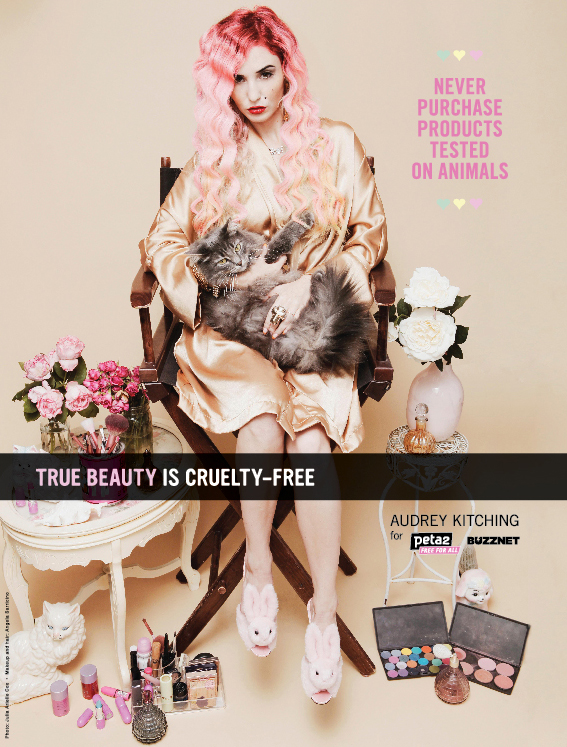“Ask the experimenters why they experiment on animals, and the answer is: ‘Because the animals are like us.’ Ask the experimenters why it is morally OK to experiment on animals, and the answer is: ‘Because the animals are not like us.’ Animal experimentation rests on a logical contradiction.” – Professor Charles R. Magel
American fashion blogger, model, and fashion designer, Audrey Kitching is an ultimate beauty in the truest sense.
Teamed with her unconventional style, classic good looks and a strong sense of enterprise within the business industry, she is not only intelligent and beautiful, but also compassionate towards her fellow living beings.
Kitching values the lives of her animal friends, and has continuously supported peta2 in their animal rights campaigns, herself appearing in the ‘True Beauty is Cruelty-Free’ movement bringing awareness to the cruelty of animal testing.
So how can we follow in her footsteps?
Animal Testing 101
Hundreds of thousands of animals are poisoned, blinded, and killed every year in archaic product tests for cosmetics, personal-care products, household cleaning products, and even fruit juices.
Although more than 1,300 companies have banned all animal tests, some corporations still force substances into animals’ stomachs and drip chemicals into rabbits’ eyes. These tests are not required by law, and they often produce inaccurate or misleading results—even if a product has blinded an animal, it can still be marketed to you.
Alternatives To Animal Testing
Fortunately, scientists have developed sophisticated product tests that are faster, cheaper, and far more accurate than blinding and poisoning tests, which were developed in the 1920s.
Human cell cultures and tissue studies (in vitro tests) and artificial human “skin” and “eyes” mimic the body’s natural properties, and a number of virtual organs serve as accurate models of human body parts.
What’s wrong with animal experiments?
Cruelty: It is common practice for animals in laboratories to be restrained and unable to move or at best, confined to small cages. In the laboratory an animal may be poisoned; deprived of food, water or sleep; applied with skin and eye irritants; subjected to psychological stress. Most suffer a slow agonizing death inside many well-known research institutions.
Species differences: A drug tested on a non-human animal cannot be assumed to cause the same result in a human as each species of animal may differ metabolic rate, physiology and immunology.
How you can be a cruelty-free beauty
– Don’t purchase animal tested products. Check the label to be sure it is cruelty free – it should specifically say so. For a current list of animal-friendly products visit Choose Cruelty Free.
– Top brands to get you started: Lush, Eleven Australia, Kevin Murphy, Burts Bees, Smashbox, Dermalogica, and Urban Decay
– Your favourite brand tests on animals? Send them a letter or pop them an email informing them of the cruelty-free alternatives
– Only donate to humane research charities. Click here to see a list of humane charities you can donate to.


Leave a Reply